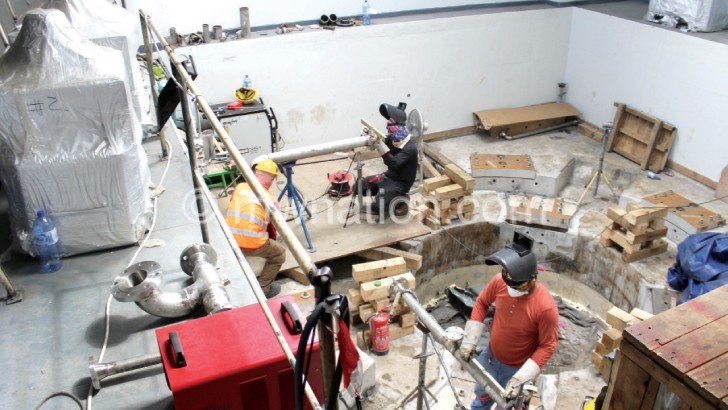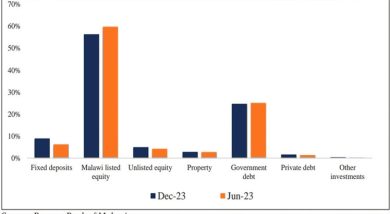The rebirth of nkula a is nigh
A new lease of life is stacking at Nkula A Hydropower Plant, located on the Shire River, about 50 kilometres northwest of the commercial city of Blantyre.
Only positive minds full to brim with optimism are currently counting down a few months remaining for the country’s oldest power plant to embrace a total renaissance.
Those that hold a strong conviction that energy is a catalyst to development would also attest that a well-functioning energy sector requires that Nkula A undergoes a complete overhaul to increase its efficiency.

Just fancy the brutal truth that the first unit of the three units at Nkula A was commissioned in 1966 and the last one in 1992. Over the years, no major maintenance works were undertaken to revive the ageing machine. This meant that most of the equipment at Nkula A, with a design capacity of 24 megawatts (MW) were completely obsolete.
Due to its old-age, the hydropower plant has frequently experienced numerous forced outages over the years; hence, an overhaul was the only panacea for a stable power supply from this power station.
As it stands now, the 24MW Nkula A Hydropower Plant is still shutdown to allow contractors do rehabilitation and modernisation works, which have intensified and are within schedule.
A slice of MCC investments
Fast forward to April 2017, a new trajectory was cast open at Nkula A. Thanks to the $350.7 million (K262 billion) Malawi Compact grant, a five-year project which entered into force in September 2013 and is due to close on September 20 2018, courtesy of the people of USA, through the Millennium Challenge Corporation (MCC), which is a United States (US) foreign aid agency, under the compact programmes to reduce poverty through economic growth.
At Nkula A, a slice of the $350.7 million cake has been pumped into rehabilitating, upgrading and modernising the power plant to improve the availability of power in the country by reducing outages caused by the conditions of the assets at Nkula. This is part of the broader efforts aimed at increasing access to electricity in the country. It is a broader effort because, apart from rehabilitating Nkula A, the compact funds have been invested in expansion of the power transmission and distribution network, power sector reforms and environment and natural resources management in the upper and middle Shire River catchment areas.
It is expected that such investments will create an enabling environment for the private sector to enter the market in power generation and transmission in future.
Back to Nkula A, this is the only project in the compact’s only generation investment in the country by MCC.
A joint venture by contractors Andritz Hydro and Mota-Engil seems to be enjoying a good working relationship in ensuring that Nkula A is rejuvenated and is clad in modernity attire.
For now, forget about the jargon generically used by engineers at the site in their day-to-day execution of duty. This modernisation processes at Nkula A is extended to the plant’s intake and draft tube gates, penstocks, installation of new turbine runners and non-rotating turbine components, complete new generators, mechanical and electrical auxiliary systems, as well as a new high-voltage 66 kilovolts (kV) hybrid switch gear.
Almost all of these machines were ineffective, rusty and in some extreme cases, obsolete.
But to date, MCC investment is replacing the old machines with the new and modern equipment.
Just embark on a sojourn to Nkula A and you will be greeted with the ambiance pregnant with hope as you see towering cranes in the thick of things while sighting newly-fixed equipment radiating at the new switchyard, inside the power house or at the intake itself.
Fruits of refurbished Nkula A in the offing
There are some anticipated benefits to be accrued from the modernisation of Nkula A and Malawians cannot wait any longer to see such benefits trickling down to them.
For so many times, it has been repeatedly highlighted in various fora organised by MCA-Malawi and compact implementing partners such as Malawi Energy Regulatory Authority (Mera), Electricity Supply Corporation of Malawi (Escom), Electricity Generation Company (Egenco) and the Ministry of Natural Resources, Energy and Mining that Nkula A rehabilitation will help improve the power station, modernise it, thereby extending its lifespan to about 30 to 40 more years. This will, therefore, help avoid a partial or total failure of the plant.
As if that is not enough, an extra 12MW (from 24 to 36 megawatts) will be unleashed to the national electricity grid, once the project completes in August this year.
However, it is imperative to understand that the essence of these works under the Malawi compact is not to increase the country’s generated megawatts of electricity by colossal margins, but improve the reliability, availability and quality of power supply. The idea is to increase the output and stability of the national electricity network while at the same time increasing efficiency of hydropower generation.
Powerful symbol of Malawi-American relationship
It is indisputable fact that the US Government, under the Malawi compact, is investing huge sums of money to ensure that the country’s power sector is nourished, transformed and is functioning to its full potential. As such, an investment designed to modernise Nkula, estimated at around $48 million (K35 billion), speaks volumes of a strong bond of partnership between the two governments.
“These investments in the power sector made by MCC is symbol of our Malawi-America partnerships,” says US Ambassador to Malawi Virginia Palmer.
But to her, what is critical is that Escom, Egenco, Mera and the Ministry of Natural Resources, Energy and Mining must sustain US Government investments such as that of Nkula A, saying doing so will ultimately benefit millions of Malawians for decades to come.
Tellingly, as Palmer stated during a 4th Semi-Annual Review Forum in Lilongwe convened by stakeholders in the energy sector, the investments in the power sector will position Malawi to meet its ambitious goals of supplying power to about 30 percent of the population by 2030 while at the same time quadrupling the current generation levels to 1 875MW.
MCA-Malawi chief executive officer Dye Mawindo said the refurbishment of Nkula A, just like other investments under the Malawi compact, are aimed at supporting the Malawi Government to increase the capacity and stability of power and the efficiency and sustainability of hydropower generation.
But as for now, the resurgence of Nkula A is nigh and it is a matter of unrelenting ticking time, thanks to the USA taxpayers. n
*Dumbani Mzale is the communications and online media officer for MCA-Malawi





